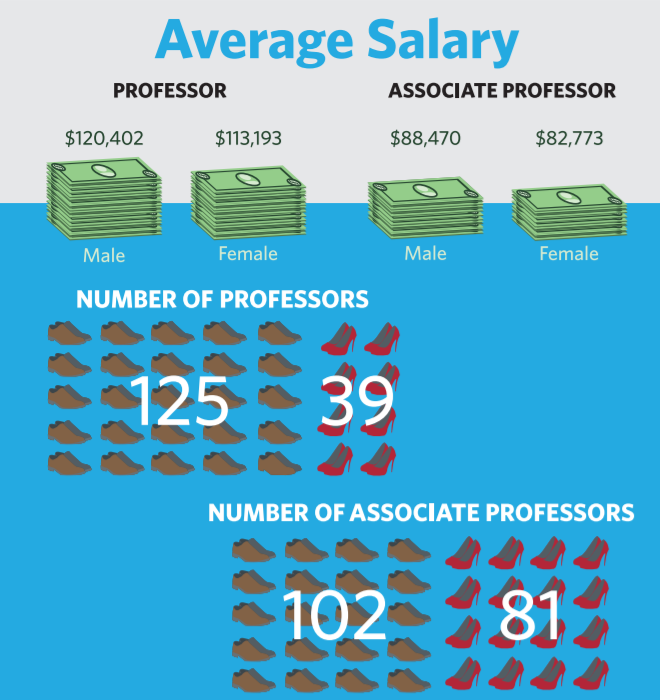
We’ve all heard about the wage gap: the fact that men make a higher salary than women based off of their aggregate pay for the year. The current gender pay gap is estimated to be around 20 percent, meaning that women only earn 80 cents per each dollar that a man makes. There are some professions in which the gap is larger, like pilots and physicians, but it is also apparent in teaching, particularly at the collegiate level. In fact, female professors at Binghamton University are suffering from this wage gap, earning less than their male counterparts throughout the entirety of their careers.
Associate professors at BU make an average of $85,950 per year, but this number is greater for men and less for women; men make $88,470 and women make $82,773, according to data for the 2015-16 school year compiled by the Chronicle of Higher Education. This means the gender pay differential per year is an average of $5,697 for associate professors, a 6.4 percent difference.
This gap still exists when you look at data reflecting the salaries of full professors at the University. Female professors only earn $113,193 compared to men’s $120,402 a year. This is a difference of $7,209, a 6 percent difference.

These numbers are troubling in themselves. The idea that the women aren’t earning as much as men at this otherwise progressive university is, at the very least, embarrassing. Compared to the national average, female BU associate professors earn similarly less proportionally to their male candidates. On the bright side, female professors at BU do relatively better than the national average, which is a 12.4 percent gap between men and women. Nevertheless, our university should not hold itself to average standards as it strives to become premier.
Part of this issue may be related to BU’s promotion of women, or lack thereof. In addition to an alarming wage gap, our university is suffering from a substantial employment gap when looking at the difference in the number of male and female full professors employed. While, according to 2015 data from the Chronicle of Higher Education, BU has a total of 164 professors, only 39 of these are women — fewer than 25 percent. In contrast, there are 125 male professors, dominating over 75 percent of employees with full professorships.
This gap, though still present, is less apparent when compared to the ratio of male and female associate professors: BU employs 102 men and 81 women with the title of an associate professor. Women make up around 44 percent of this category, much closer to a one-to-one ratio of men to women.
Obviously, it is an assumed goal of teachers to eventually obtain a professorship, or to be upgraded from an assistant professor. However, it is evident from these numbers that men are being promoted at a higher rate than women, which perhaps is one of the causes leading to the lack of wage equality. Though associate professors exist in almost similar amounts — the key word is almost — women are noticeably underpromoted when it comes to full professorships.
It’s important to note that this isn’t primarily about money. The issue of the wage gap pertains to equality far more than personal gain, to the idea that women should be considered to be of identical worth to men in every aspect, especially in their professional careers. The fact that BU does not support women as equally as men sends the wrong signal to every student and employee who walks through the doors of this college and makes me less far less proud to say that I am a member of this university.
Emily Houston is a sophomore double-majoring in English and political science.


